Friday, November 1, 1929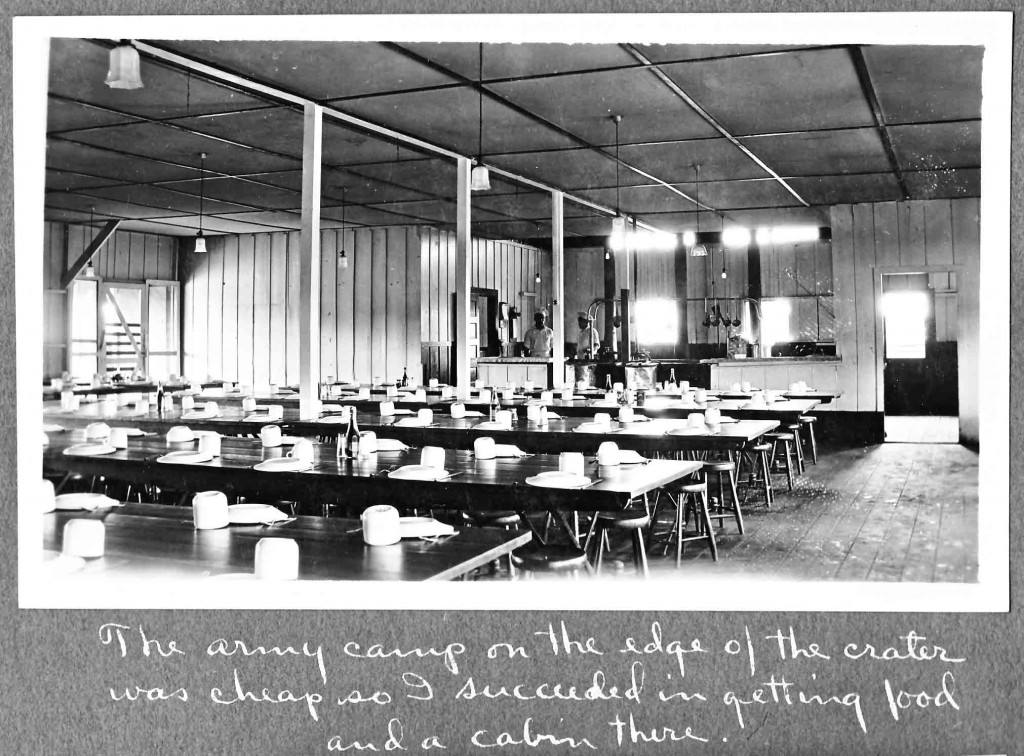
Up with the sun—and it wasn’t a bugle that did it either. Rather, my intuition that told me food was brewing—and a jolly good hunch it was too, for a half hour later, at six, the breakfast bell rang and I wasn’t the last in the mess hall. It’s a crime the way these boys toss food down—all out for speed records. Not much sense in it for this is a rest camp for 200 men, not a race track. Well, I’m on to it now. Made up for lost time at lunch and dinner. The idea (if you eat plenty like I do) is to shovel and gulp with great speed. If a tie-up in traffic results, ease a half cup of coffee into the throat and immediately start shoveling again. Never be the last to leave! If still hungry, stuff your mouth, ears, and hands full before you leave. My degree of perfection to date allows me two helpings of everything and gets me away before the last dozen—all in about 15 minutes.
Being a fool, I again rode the bike today—23 miles before noon on a tour of a number of craters.
The Hawaiian National Park on this island is 219 square miles and includes the volcanoes. In 1927 there were about 35,000 visitors—in 1928 some 78,000.
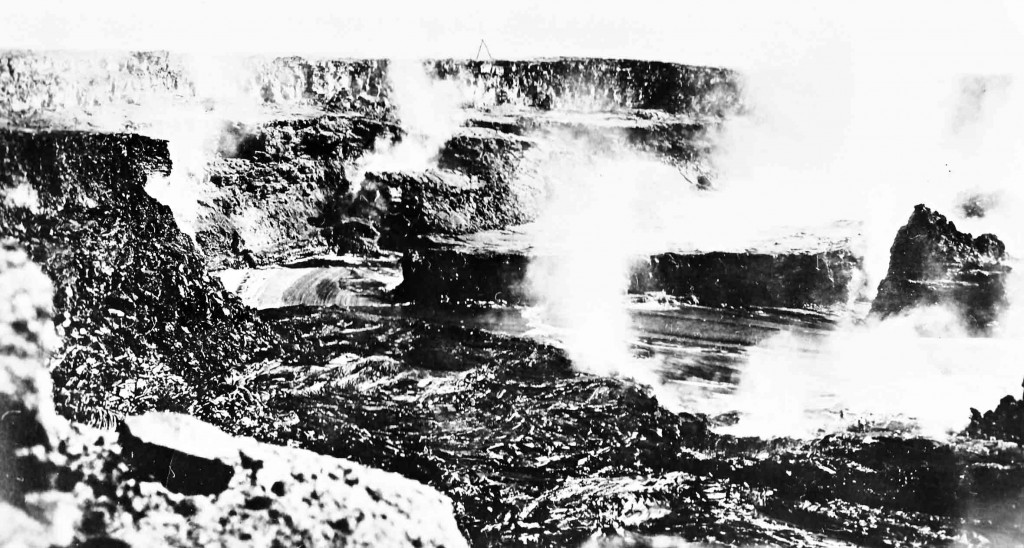 The volcanoes are harmless, practically, and quite active. Kilauea has been more or less active now for a century, having a lake or lakes of molten lava. Mauna Loa is the largest active volcano and mountain mass in the world, and has eruptions about once a decade. Kilauea is not part of Mauna Loa but a separate volcano and mountain. It is nearly 8 miles in circumference and 600 feet deep; the crater encloses 2,650 acres of fantastically-shaped solid lava. A little “off center” is Halemaumau, a vast pit known as the House of Everlasting Fire. At the present time it is over 2 miles in circumference, 3,500 ft. across its greatest diameter, and as to depth, I am not certain. In January it was 1,300 ft. deep, a perpendicular drop to the banks of talus piled about the edges where it falls from the walls. At first I thought it but about 700 ft down, but a second look changes my mind—to more nearly a thousand. The lava on the floor is hard. About half way up the western wall are two lava tubes, apparently empty. All about the pit are great cracks from earthquakes. Steam issue from some, reminding one that all is not as dead as it seems. The spectacle is awing, and as you follow the edge around over the cracks and rough lava, you begin to feel pretty insignificant and—creepy if you stay close to the edge. Just one earth tremor might complete the crack and send you hurtling down to the lava a thousand feet below. Still, on second thought, why be bothered. The odds are in your favor and why miss the tremendous view of the terrible walls and hardened lava lake below? Two feet from the edge is as safe as ten if you don’t get giddy.
The volcanoes are harmless, practically, and quite active. Kilauea has been more or less active now for a century, having a lake or lakes of molten lava. Mauna Loa is the largest active volcano and mountain mass in the world, and has eruptions about once a decade. Kilauea is not part of Mauna Loa but a separate volcano and mountain. It is nearly 8 miles in circumference and 600 feet deep; the crater encloses 2,650 acres of fantastically-shaped solid lava. A little “off center” is Halemaumau, a vast pit known as the House of Everlasting Fire. At the present time it is over 2 miles in circumference, 3,500 ft. across its greatest diameter, and as to depth, I am not certain. In January it was 1,300 ft. deep, a perpendicular drop to the banks of talus piled about the edges where it falls from the walls. At first I thought it but about 700 ft down, but a second look changes my mind—to more nearly a thousand. The lava on the floor is hard. About half way up the western wall are two lava tubes, apparently empty. All about the pit are great cracks from earthquakes. Steam issue from some, reminding one that all is not as dead as it seems. The spectacle is awing, and as you follow the edge around over the cracks and rough lava, you begin to feel pretty insignificant and—creepy if you stay close to the edge. Just one earth tremor might complete the crack and send you hurtling down to the lava a thousand feet below. Still, on second thought, why be bothered. The odds are in your favor and why miss the tremendous view of the terrible walls and hardened lava lake below? Two feet from the edge is as safe as ten if you don’t get giddy.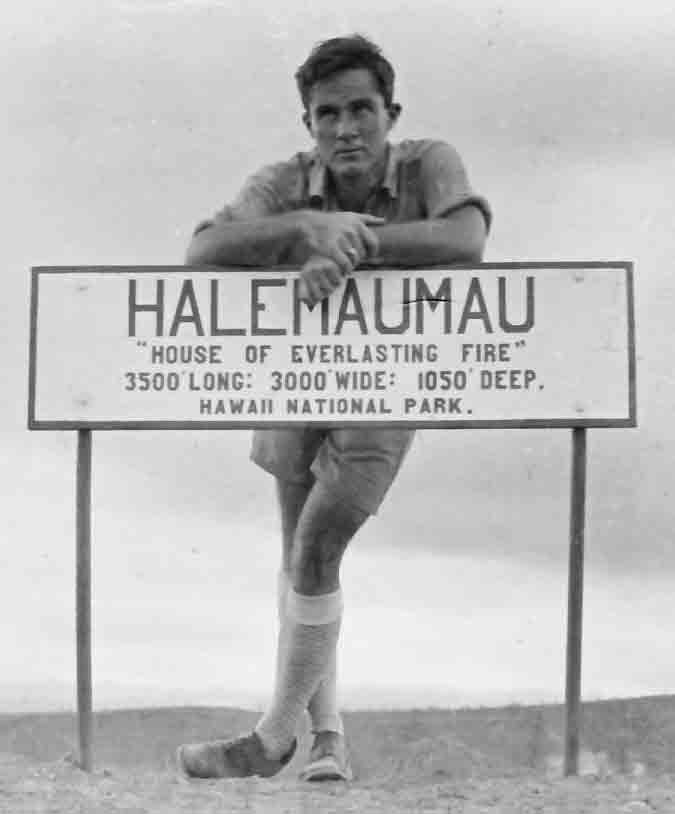
Halemaumau may be approached by two ways—first and laziest by an auto road that winds down around Kilauea-Iki Crater through the fern jungles and finally out upon a sand spit extending down across the floor of Kilauea—now extended to the very edge of the fire pit. Thus one can motor comfortably to within 50 feet of a world-famous active volcano.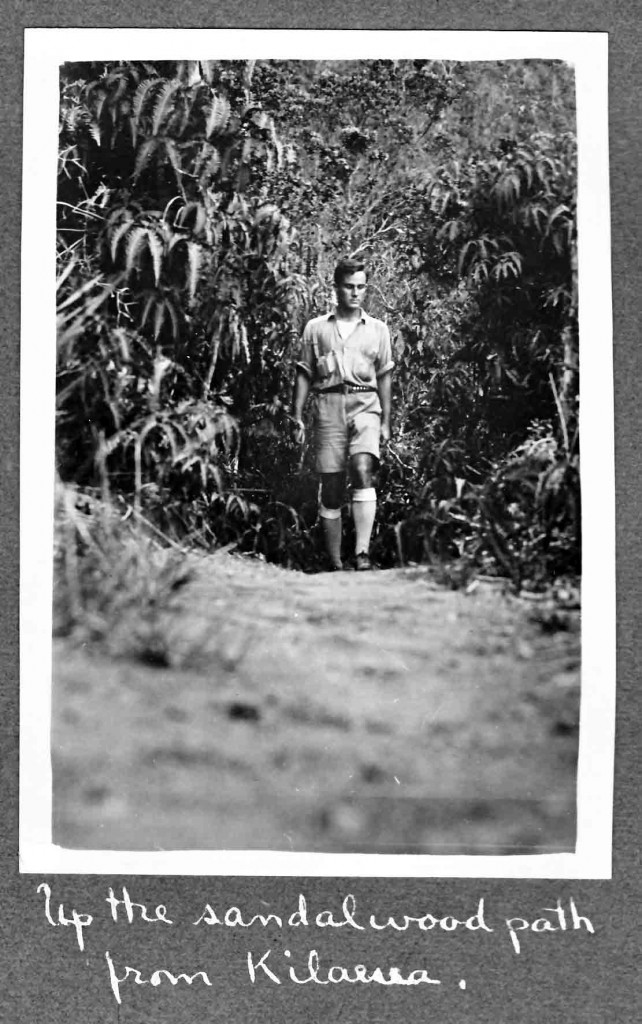
The second way is known as “the world’s weirdest walk.” You climb down into Kilauea either from the Volcano House path or the Sandalwood Trail from the Steaming Cliffs. A wide variety of trees and shrubs are to be seen, not only here, but also all throughout the park. The Alani, a small tree dedicated to Pele, Goddess of Volcanoes; Ohelo, a shrub with inconspicuous flowers but fine for pies—it is the Hawaiian huckleberry; Ohia, the most plentiful tree on the island; Iliahi or sandalwood; varieties of ferns, many attaining a height of 40 feet; Pukeawe or Hawaiian Heather; Koa or Hawaiian mahogany, the stateliest tree in Hawaii. Along the Sandalwood Trail many earthquake cracks and steam vents give you a warm reception as you go by.
This trail ends on the crater floor—and here the weird part begins. A line of stones over the lava marks the trail to Halemaumau. The lava in cooling has taken on all sorts of fantastic shapes—it has formed in huge waves, then broken off in large blocks—it has formed in ripples like sand, been pulled around in curves and twisted like rope—it has come in even flows, one above the other and each latter one a bit retarded, oozing over like thick molasses—great sections have been puffed up as though filled with hot air, then broken in half, leaving a cave, a half-bubble of lava a foot or so thick. The mass is twisted, pulled, depressed, raised, broken into an overwhelming sea of black porous rock, hemmed in by walls of the crater 300 to 500 ft. high.
If you observe closely, you can sometimes distinguish between the different flows of lava, either by color or formation. But there are signs telling you the dates of the various flows. One section is crossed where the lava is extremely rough and broken up as of there had been a bombardment of it. If my geology fails me not, this type of rough lava is called aa, or perhaps the term only applies to a flow.
Shortly after you pass a small lava cone, the Little Beggar I believe it is called, them you enter an area of loose stones, the result of volcanic bombardment. Volcanic dust is very fine and each step kicks up a cloud of it. At the end of the long gentle slope is Halemaumau in all her glory and terror.
So passed the afternoon—but as for the morning—
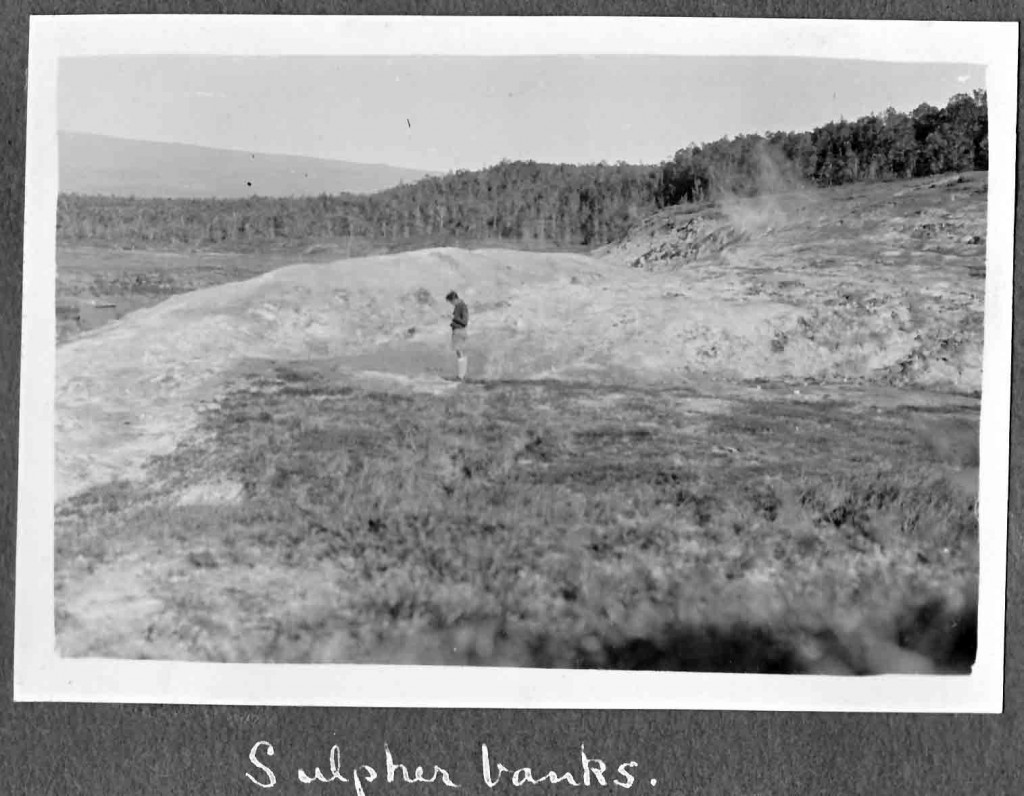 The forming sulphur banks and steam vents but a half mile down the road from camp first attracted my attention. From here I rode to what are known as the Twin Craters. Neither is very large and are homes for a copious growth of tropical ferns and vegetation. One is blessed (?) with a lava tube, thus attracting multitudes of visitors and gaining a little glory and attention for its twin crater at the same time.
The forming sulphur banks and steam vents but a half mile down the road from camp first attracted my attention. From here I rode to what are known as the Twin Craters. Neither is very large and are homes for a copious growth of tropical ferns and vegetation. One is blessed (?) with a lava tube, thus attracting multitudes of visitors and gaining a little glory and attention for its twin crater at the same time.
If one is in doubt of his guts, crust, courage, or sand (as you please), or in search of a big kick or spooky sensation, let him tackle a lava tube without a light. That would probably be a dangerous thing to do, but here we have a tube that is known to be harmless, not bad walking, pitch dark, curved, and 400 feet long. It is open at each end—yet knowing all of this you stop 25 feet from the entrance and wish to gosh you had a match. If you remain in the dark a few minutes you can barely make out the walls near you. Feeling cautiously before each step you proceed into the ink-black foot by foot. Looking back you see the entrance, a round light hole in the distance, perhaps 250 feet but seemingly much farther. Ahead you see something that is not quite black, or think you do. It is way off in the distance, yet a dozen steps bring it before your face. Then you notice a faint glow to the left and feel your way along in that direction, hands before and above you. Two minutes later you are standing at the foot of a flight of wooden stairs leading out through a hole in the roof. Beyond the tube continues, and descends I believe, but here a light is necessary for there is no exit at the other end—for it goes down into the depths of the earth. With a light I understand one can follow it several hundred feet. Having come across no spooks or pits as are sometimes found in lava tubes, your return through the tube is a little faster and more sure—though far from speedy.
cautiously before each step you proceed into the ink-black foot by foot. Looking back you see the entrance, a round light hole in the distance, perhaps 250 feet but seemingly much farther. Ahead you see something that is not quite black, or think you do. It is way off in the distance, yet a dozen steps bring it before your face. Then you notice a faint glow to the left and feel your way along in that direction, hands before and above you. Two minutes later you are standing at the foot of a flight of wooden stairs leading out through a hole in the roof. Beyond the tube continues, and descends I believe, but here a light is necessary for there is no exit at the other end—for it goes down into the depths of the earth. With a light I understand one can follow it several hundred feet. Having come across no spooks or pits as are sometimes found in lava tubes, your return through the tube is a little faster and more sure—though far from speedy.
Some distance farther the road branches, one to the right leading down into Kilauea crater to Halemaumau, the second known as the Chain Crater Road, leading past 8 craters—7 miles in length, erected at a cost of $150,000. How much per mile please? Per foot? The Kilauea-iki extinct crater has been passed before reaching the branch. This crater is 770 feet deep, perhaps ¾ mile wide and was last active in 1868. Trees and shrubs grow on its floor and where they can find a foothold in the near-perpendicular walls. A narrow plateau separates this crater from Kilauea, higher than the floor of either yet lower than the rim walls.
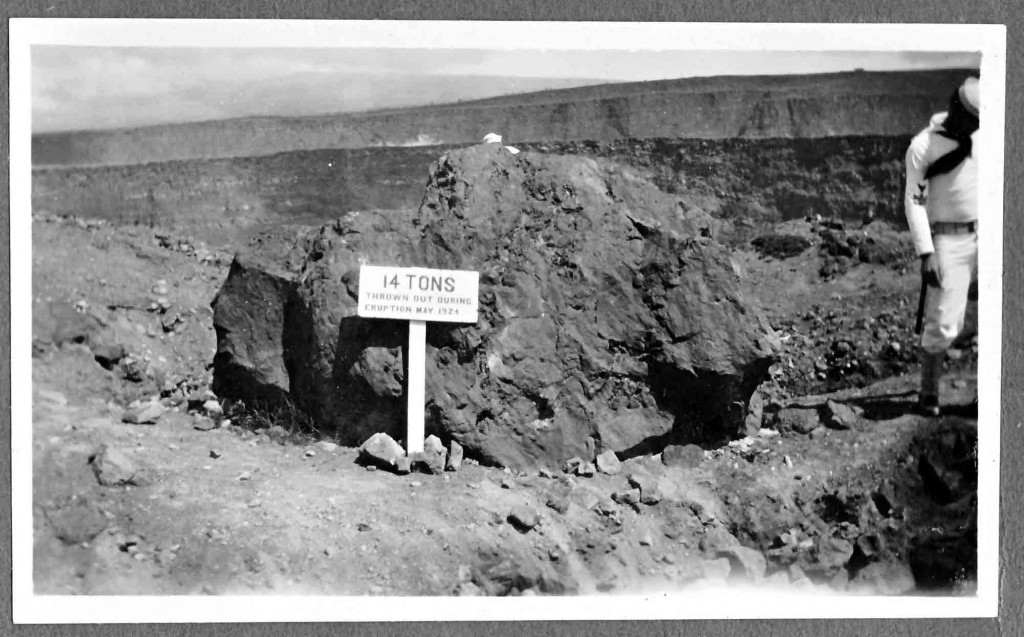 Riding down the Chain Crater Road in the morning is a splendid experience. Notice I said down—up is quite different. Every few minutes you pass an old crater, dismount, and peer down into the depths, register awe, defeat and kindred emotions, then peddle on to the next. In order they are:
Riding down the Chain Crater Road in the morning is a splendid experience. Notice I said down—up is quite different. Every few minutes you pass an old crater, dismount, and peer down into the depths, register awe, defeat and kindred emotions, then peddle on to the next. In order they are:
1. Lua Manu–200 ft deep; 2. Puhimau–350 ft deep; 3. Kokoolau–100 ft deep.
Then comes a small lava peak and a place a few feet away called Devil’s Throat—a darned good name for that. The neck is perhaps 35 or 40 feet in diameter and extends down in a straight drop 250 feet into the ground. If anything, the top edge overhangs the dark cavernous depths below. Then we come to the larger craters
4. Heake–500 ft deep; 5. Pauahi–452 ft deep, “Burned out”; 6. Aloi–240 ft deep, “Swamp”; 7. Alealea–490 ft deep, “Bright”; 8. 1000 ft deep “Eye of the Eel”.
The latter is larger by far than its neighbors. A fourth of its area seems to have suffered later volcanic activity and is several hundred feet below the level of the remainder of the crater floor. Trees and shrubs grow in all, and all have perpendicular walls or nearly so. The section north of these craters is rich in vegetation. That to the immediate south and west is covered with scrawnier and hardier dwarfed trees and shrubs struggling up through the various flows of lava rock. Farther to the southwest is the Kau Desert, barren and lava clad, cracked by earthquakes and dotted here and there with small cinder and lava cones and pit craters. From this road one also has a splendid view of Mauna Loa with its many lava flows shoving up from the green slopes from which steam issues in thin white clouds—and not infrequently, lava.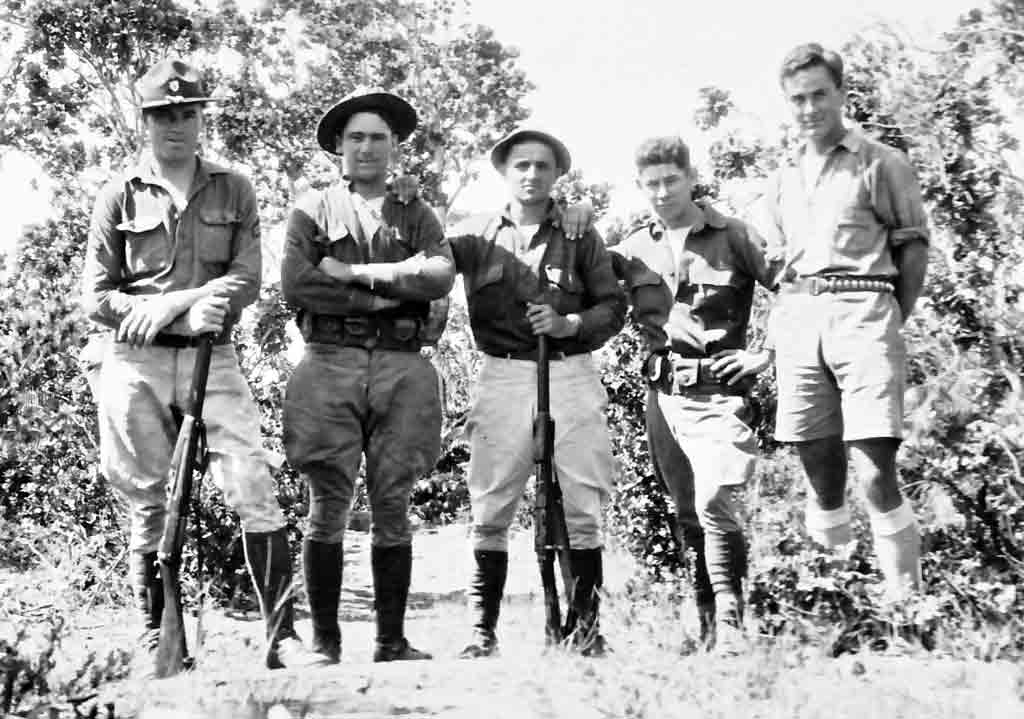
Seems to me I came down-hill to these craters. That means up-hill to get back to camp. Now, it happens that there has been no rain in these parts for six weeks or three months or some such lapse of time. Not only is water scarce, even in camp (no baths), but the ground is all dried up and in a mid-day sun one can become pretty uncomfortable. But Pauahi Crater is blessed with a shelter house which was further blessed with some water in a tank. Therefore I consumed great quantities and was saved.
 Some soldier friends came along on a hike and I learned I had only a short time to do the 7-odd remaining miles back to camp or miss my lunch. In spite of hills I made good time back and arrived with 15 minutes to spare. Sure killed myself with the effort but better dead and not miss a meal than alive and hungry. And speaking of meals, I am deeply moved to comment on the speed of the K.P. If 190 men can eat and toss their scraped plates into the wash sink in 15 minutes, the K.P. can have them all washed, tables cleaned and reset and floor swept up in 20—before the last man has finished. One is supposed to overlook any vestiges of former meals left on silverware, etc.
Some soldier friends came along on a hike and I learned I had only a short time to do the 7-odd remaining miles back to camp or miss my lunch. In spite of hills I made good time back and arrived with 15 minutes to spare. Sure killed myself with the effort but better dead and not miss a meal than alive and hungry. And speaking of meals, I am deeply moved to comment on the speed of the K.P. If 190 men can eat and toss their scraped plates into the wash sink in 15 minutes, the K.P. can have them all washed, tables cleaned and reset and floor swept up in 20—before the last man has finished. One is supposed to overlook any vestiges of former meals left on silverware, etc.
